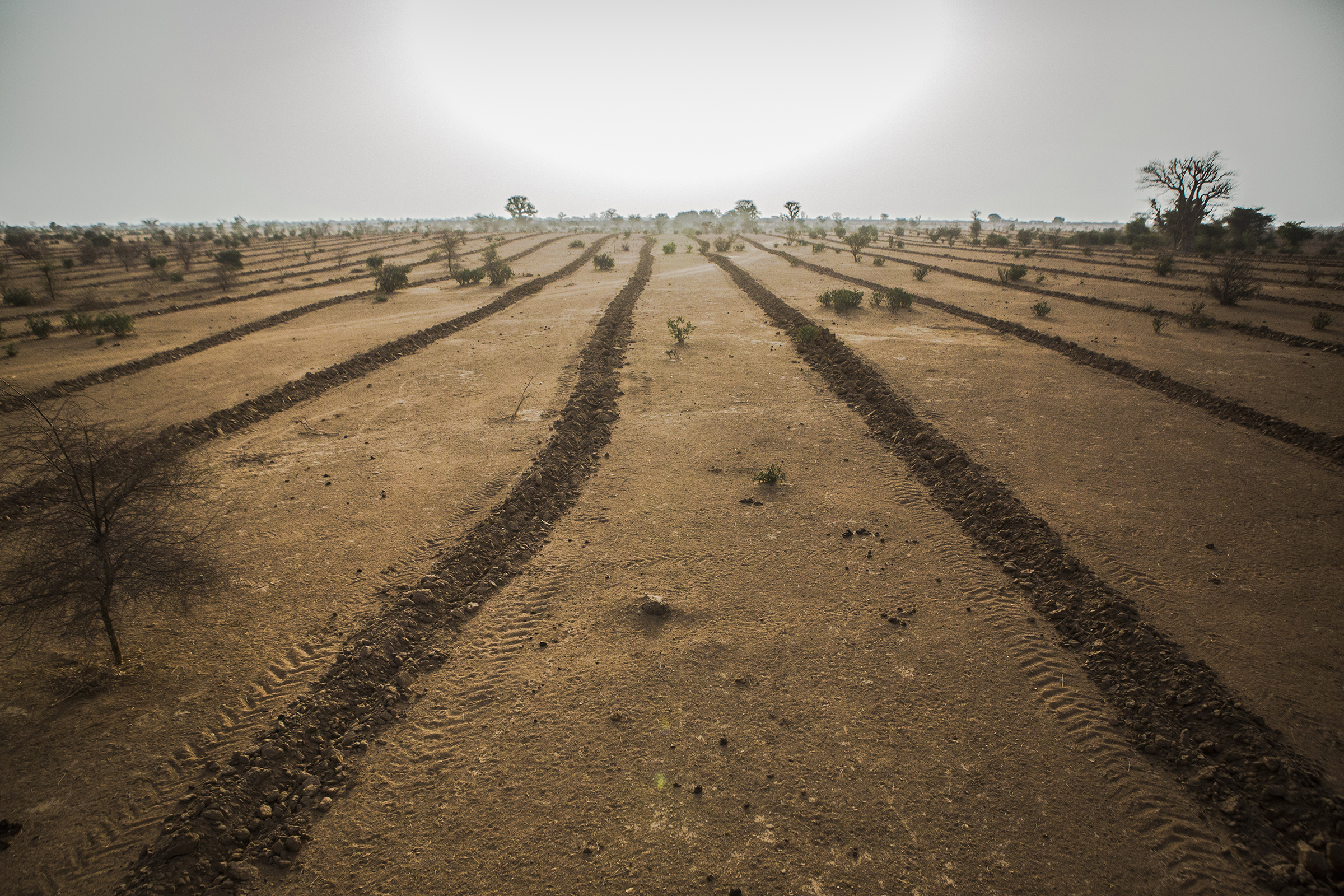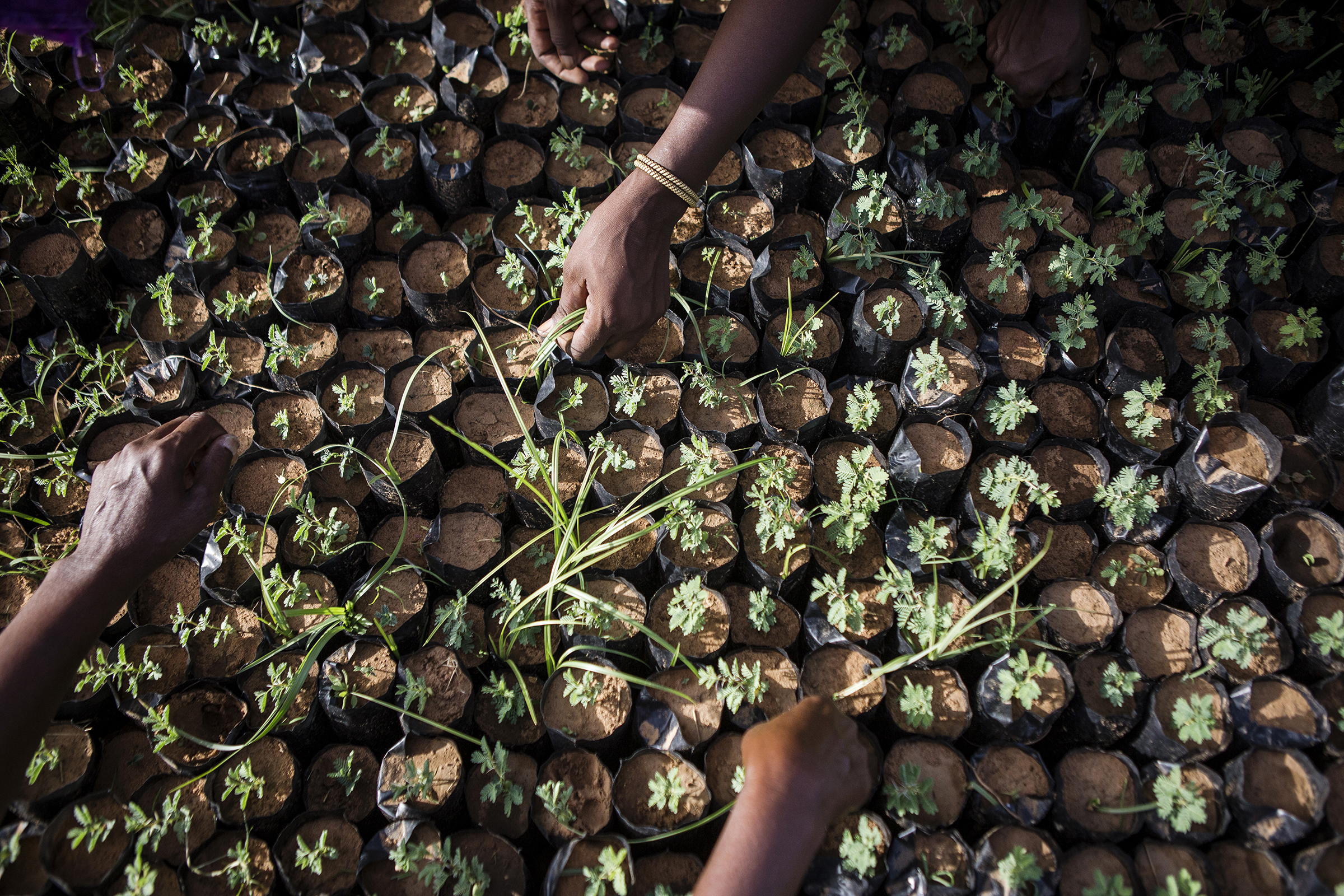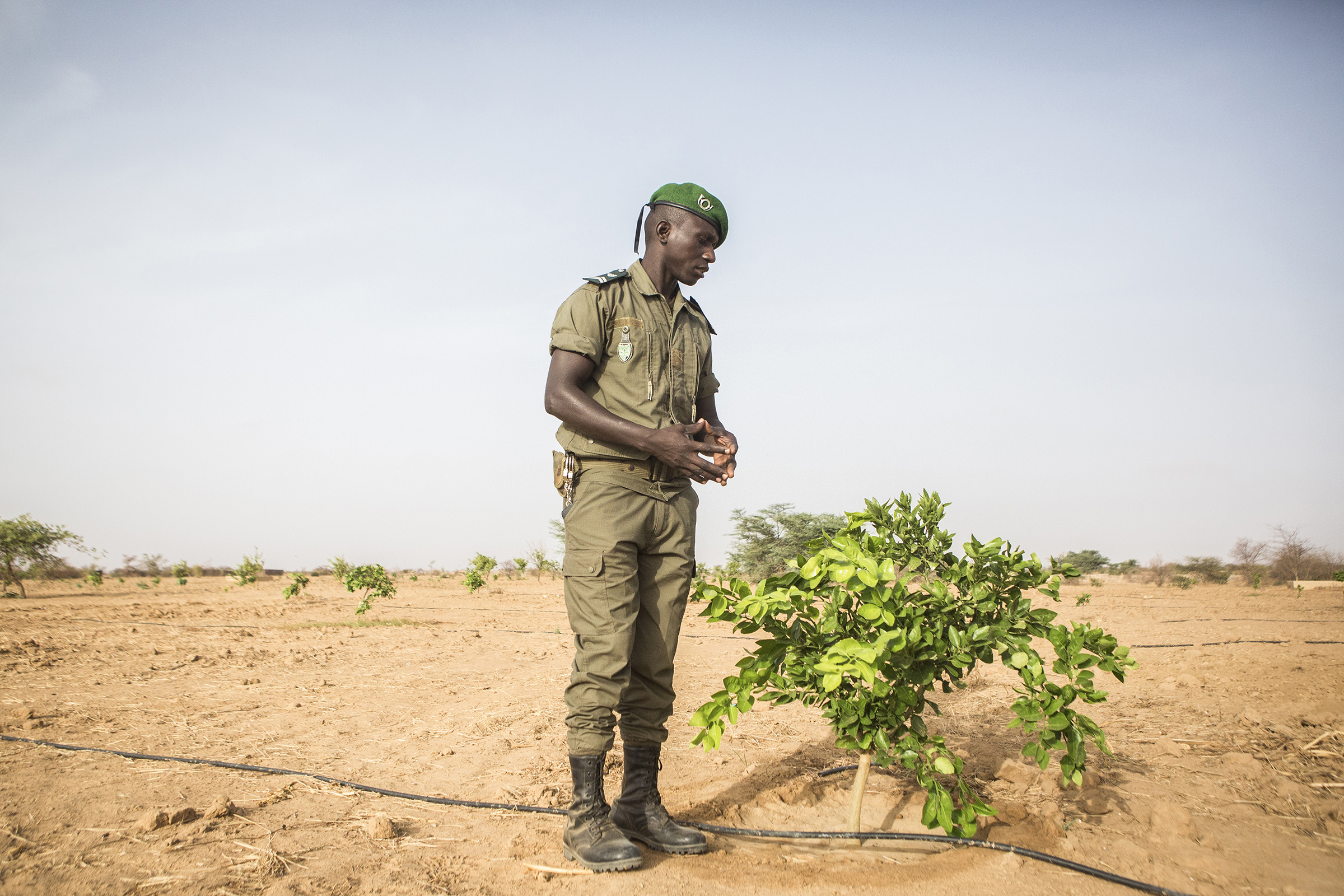The seedlings are ready. One hundred and fifty thousand shoots of drought-resistant acacia, hardy baobab and Moringa spill out of their black plastic casings. The ground has been prepared with scores of kilometer-long furrows leading to a horizon studded with skeletal thorn trees. It’s early August, and in less than a week, 399 volunteers from 27 countries will arrive in this remote corner of northern Senegal to participate in one of the world’s most audacious efforts to combat the effects of climate change: an $8 billion plan to reforest 247 million acres of degraded land across the width of Africa, stretching from Dakar to Djibouti.
The Great Green Wall project, spearheaded by the African Union and funded by the World Bank, the European Union and the United Nations, was launched in 2007 to halt the expansion of the Sahara by planting a barrier of trees running 4,815 miles along its southern edge. Now, as concerns mount about the impact of climate change on the Sahel, the semiarid band of grassland south of the Sahara that is already one of the most impoverished regions on earth, the Great Green Wall is filling a new role. The goal now, say its designers, is to transform the lives of millions living on the front line of climate change by restoring agricultural land ruined by decades of overuse; when done, it should provide food, stem conflict and discourage migration. When the project is completed in 2030, the restored land is expected to absorb some 250 million metric tons of carbon dioxide from the atmosphere, the equivalent of keeping all of California’s cars parked for 3½ years.
Over the course of a week, the volunteers descending upon the Senegalese village of Mbar Toubab will try to turn 494 acres of barren land into another forested brick in the Great Green Wall. There is only one problem: the annual rains have yet to arrive, and without them, none of the seedlings will take root. “The rain used to come in June. Here we are in August, and still there is no rain,” says El Hadj Goudiaby, who has spent the past nine years overseeing Great Green Wall projects in Mbar Toubab for Senegal’s forestry department. How is it possible, he asks, to grow trees to combat climate change if climate change is making it impossible to grow trees?
The answer may have more to do with changing attitudes than changing the landscape. When people think of potential fixes for global warming, they tend to focus on big projects. But if human activity is at the root of climate change, whether it be the carbon emissions of the industrialized world or the overgrazing of the Sahel, then that is where the solution lies as well. Environmentalists celebrate the Great Green Wall for its epic territorial ambition, but its biggest impact will come from allowing people to meet their needs without destroying nature in the process.

The Sahara isn’t expanding so much as the Sahel is shrinking, destroyed by decades of overgrazing, climate-change-induced drought and poor farming practices that have stripped the once lush grasslands of the fertile topsoil needed to regenerate. Cattle herders resort to the few remaining trees for animal fodder, denuding the landscape even further in a downward spiral of desertification. Planting trees not only reduces carbon on a global scale—research in the journal Science estimates planting more than 2 billion acres of trees could remove two-thirds of all the emissions that human activity has pumped into the atmosphere since the Industrial Revolution—it also recharges the water table and creates microclimates that increase local rainfall. (For more on rewilding and carbon reduction, click here.) But if pastoralists have nothing to feed their herds in the time it takes those trees to mature, they are likely to use the saplings, starting the cycle all over again. Which is why, though it may not sound like much, the solution to climate change in the Sahel starts with getting grass to grow.
“If we can solve people’s problems by improving their living conditions now,” says Goudiaby, “they will be able to help themselves by protecting the trees that protect their future.” After all, stopping global warming isn’t about saving the planet; the earth will survive no matter how much the climate changes. It’s about saving humanity. One way to do that is by helping those who are most vulnerable to what chaos we have already created.
Just 25 miles south of Mbar Toubab, near the village of Koyli Alpha, 50-year-old Dienaba Aka pulls her heavily laden donkey cart to the side of the road. She and her extended family have spent the day cutting grass in a “forage bank” managed by the national Great Green Wall agency. For the past eight months, the 1,700-acre field has been fenced off to let the grass, along with 250,000 saplings, grow undisturbed by the cattle, sheep and goats that roam free in this region. The field reopened in July, and now herders pay $1.70 a day to harvest the waist-high grass for their cattle until the rains bring new grazing opportunities. For Aka, the idea of a grass “bank” is a radical departure from an itinerant childhood spent following the family herd in search of forage. Now she can feed her cattle in the lean season without stripping trees.

Aka, like women from many villages in the region, has been planting trees for the GGW project since 2012. She earns $96 during the six-week planting season. It’s good money, she says, but most women do it because they have been told it will bring back the rain, which in turn brings the grass that feeds their livestock.
There is another advantage to forage banking, Aka says, gazing proudly at her two 10-year-old nieces perched atop several bags of recently cut grass. “Before the Great Green Wall, the kids had to go with us when we took the cattle to graze. Now they can stay in school.” In Mbar Toubab, the fees collected from last year’s forage bank paid for solar panels to power classrooms. This year they will cover construction of a dormitory for students who live too far to walk every day. The circular investment is part of the plan, says Goudiaby. “If we can make the children aware of the consequences of our actions today, they will teach the next generation.”
The seedlings in Senegal’s reforesting projects are usually locally sourced and selected for their drought resistance and hardiness. Thorny desert acacias carry their own protection from grazing animals, and in the dry season they shed their leaves to conserve moisture. Once baobabs take root, they are long-lived even under drought conditions. Their bark can be used to make rope, their leaves are edible, and their foot-long fruit can either be juiced or ground up and roasted to make a coffee-like drink.
Fruit trees are often overlooked in reforestation schemes that prioritize hardiness, and that needs to change, says Ali Haider, the incoming director of Senegal’s Great Green Wall agency. “If you give someone a tree that she doesn’t need, she won’t take care of it.” Give her something she values instead, he says, something she can cook, sell or use for medicine. “Then she will protect it because it improves her life.”
Some of Senegal’s GGW agency projects do just that on a grand scale, like investing in gum arabic plantations for export. Since Senegal’s first sapling in the Great Green Wall took root in 2008, the national agency says it has planted 18 million trees on 99,000 acres of restored land. Nine market gardens are up and running, and three times as many forage banks are keeping cattle fed in the lean season. Gazelles, jackals, desert tortoises and songbirds—not seen in the region for years—are returning.
All of that amounts to very little compared with the scale of the overall problem, says Chris Reij, a senior fellow at the World Resources Institute who has been working on desertification in the Sahel since 1978. Even if 99,000 acres have been reforested in Senegal, a figure he thinks is likely inflated, the acreage of forested land disappearing because of logging, agriculture and construction in other parts of the country is many times higher, he says. “So unless you do something about that, you are still losing the battle.” Nor does he think massive plantations are the solution. The survival rate of planted trees in arid regions like the Sahel hovers around 20%. “If all the trees that have been planted in the Sahel since 1980 had survived, it would look like the Amazon by now,” he says.
Goudiaby concedes that planting trees on the edge of the Sahara may not be the most cost-effective solution to climate change. But given time, he says, it works. Over the nine years he has been working the plots of Mbar Toubab, he estimates a 70% survival rate. A walk through one of the earliest plantations in the area does show signs of progress. Some of the trees are 10 ft. to 12 ft. tall, and though it’s not exactly a forest, it’s certainly not barren land either.

Reij argues it would be more cost-effective to restore the original grasslands, which are almost as good at capturing carbon. Mali, Burkina Faso and Niger, for example, are fencing off large areas to allow the land to recover from the effects of overgrazing over time. In agricultural areas, farmers are being taught to plant around existing trees and sprouts, rather than plowing them over. The result, says Reij, “has been mind-blowing,” with 12 million acres regreened in Niger over the past 30 years.
No one approach is better than the other, says Ibrahim Thiaw, the executive secretary of the U.N. Convention to Combat Desertification. Whether countries plant trees or promote grasslands, the end result is 21 African nations are working together to combat climate change and make people’s lives better in the Sahel. His biggest concern is that so far, only 15% of the proposed area has been restored. Some of the delays are because of a lack of funding. Senegal spends $200 million a year on planting and caring for its section of the wall; poorer nations of the alliance can’t afford even that. Only half the $8 billion pledged for the project has come through, largely because other climate emergencies are drawing attention away from the Sahel.
Long-term, says Thiaw, the impact of climate change on one of the world’s most impoverished regions will have global repercussions. Some 150 million people live in the Sahel, nearly two-thirds under age 25, and the region has the highest birth rate in the world. The World Bank predicts climate change will force about 85 million sub-Saharan Africans to migrate, many to under-resourced urban enclaves in the region, while a significant number will attempt the deadly passage to Europe and the Gulf countries in search of opportunity. “It’s a time bomb,” says Thiaw.
The immediate risks are equally troubling. Across the region, governments have lost local control to extremist groups such as Boko Haram, al-Qaeda and the Islamic State. Some 4.2 million people have been displaced by drought and conflict, particularly in the region bordering Lake Chad, which used to supply fresh water and livelihoods to nearly 30 million people but has shrunk by 90% because of climate change and overuse. The lack of economic prospects provides rich recruiting prospects for Boko Haram, which can dangle employment and goods that are otherwise unavailable. Dennis Garrity, the Drylands ambassador to the U.N. Convention to Combat Desertification, likens conditions in the Sahel to those in the impoverished, ungoverned swaths of Pakistan and Afghanistan that were the font of global terrorism two decades ago. “The Sahel is not only the area most vulnerable to climate change in the world, it is also the region where terrorism and extremism are growing most rapidly,” he says.
The rains finally came to Mbar Toubab on Aug. 19, a full month later than the year before. There wasn’t much, but it was enough for the volunteers to get started, and by the time they left, 88,000 seedlings had been carefully set into the ground. The irony of people flying in from as far away as Hong Kong to plant trees to combat climate change, which is exacerbated in part by transcontinental flights, is not lost on Goudiaby. “Maybe they are making up for climate sins they have committed back in their home countries,” he proposes, a kind of climatic reparation. The countries of the Sahel contribute least to global warming, yet they reap the worst repercussions of the wealth generated by more industrialized nations. It only seems fair, he says, that members of those nations come to Senegal to pay their debts.
This is one article in a series on the state of the planet’s response to climate change. Read the rest of the stories and sign up for One.Five, TIME’s climate change newsletter.
Correction, Sept. 24: In a previous version of this story, the graphic misidentified the location of Africa’s Indian Ocean coastline.
More Must-Reads from TIME
- Donald Trump Is TIME's 2024 Person of the Year
- Why We Chose Trump as Person of the Year
- Is Intermittent Fasting Good or Bad for You?
- The 100 Must-Read Books of 2024
- The 20 Best Christmas TV Episodes
- Column: If Optimism Feels Ridiculous Now, Try Hope
- The Future of Climate Action Is Trade Policy
- Merle Bombardieri Is Helping People Make the Baby Decision
Contact us at letters@time.com
